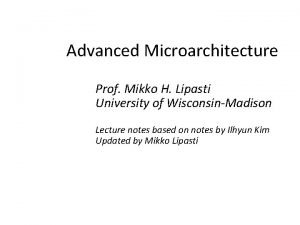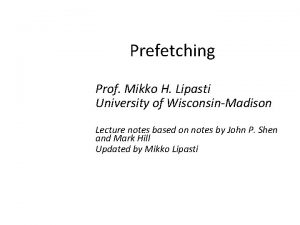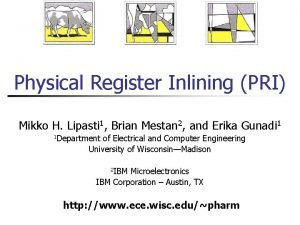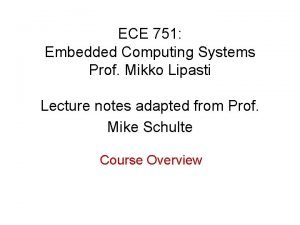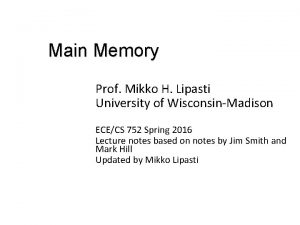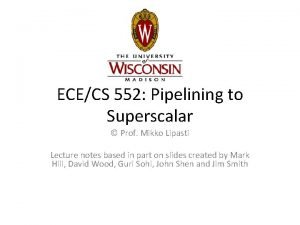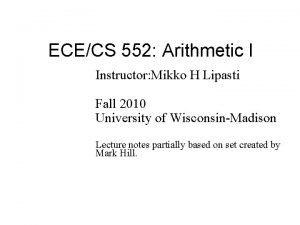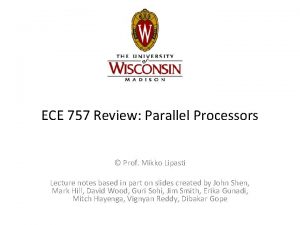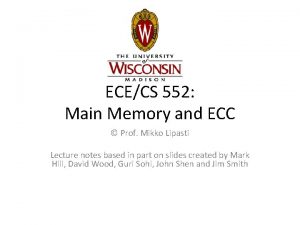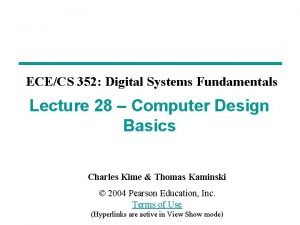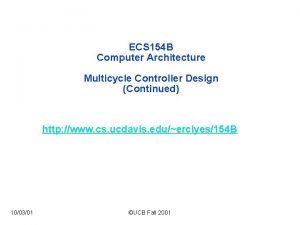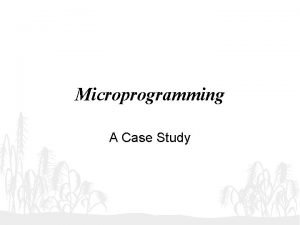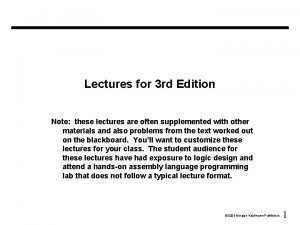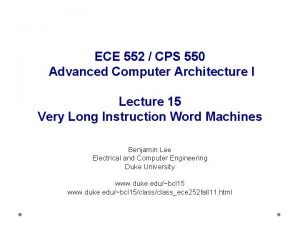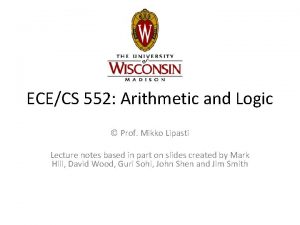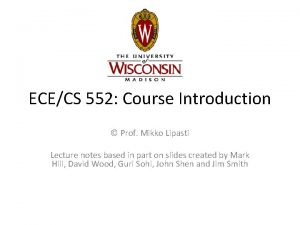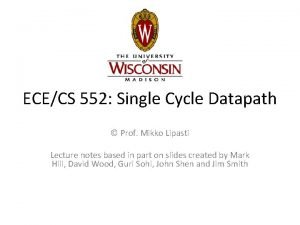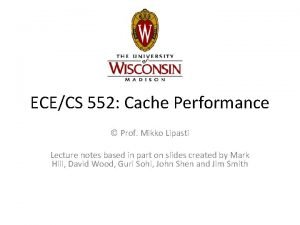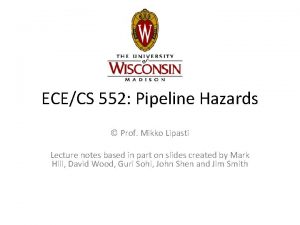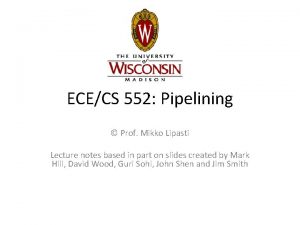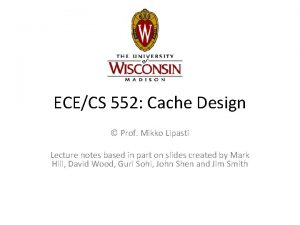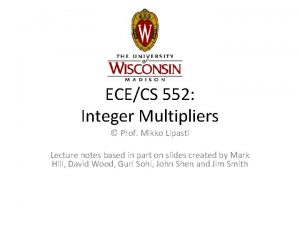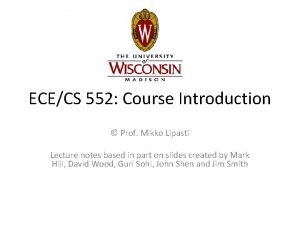ECECS 552 Microprogramming and Exceptions Prof Mikko Lipasti


















- Slides: 18

ECE/CS 552: Microprogramming and Exceptions © Prof. Mikko Lipasti Lecture notes based in part on slides created by Mark Hill, David Wood, Guri Sohi, John Shen and Jim Smith

Microprogramming • Alternative way of specifying control • FSM – State – bubble – Control signals in bubble – Next state given by signals on arc – Not a great language for specifying complex events • Instead, treat as a programming problem

Microprogramming • Datapath remains the same • Control is specified differently but does the same • Each cycle a microprogram field specifies required control signals Label Fetch Alu Add Mem 1 Add Lw 2 Src 1 Pc Pc A Src 2 4 Extshft Extend Reg Read pc Read Memory Alu Read alu Write mdr Pcwrite Alu Next? +1 Dispatch 2 +1 fetch

FSM vs. Microprogramming

Benefits of Microprogramming • More disciplined control logic – Easier to debug • • Enables family of machines with same ISA Enables more complex ISA (benefit? ) Writeable control store allows late fixes But, in the late 1980’s – CAD tools and PLAs offer similar discipline – Caches make memory almost as fast as control store

State of the Art • Specify control – FSM – does not scale easily – Microprogram – works – VHDL/Verilog – preferred • Specify control in VHDL/Verilog – CAD compile to PLA – Could use ROM or RAM

Horizontal vs. Vertical Microcode • Horizontal – Fewer and wider micro-instructions – Less encoding – Larger control store – may waste space (control lines) • Vertical – More and narrower micro-instructions – Dense encoding – Smaller control store – but may need more steps

Intellectual Heritage • Microprogramming seems dead • But what if technology shifts: – Control store is faster than caches? • Also, “Very Long Instruction Word” or VLIW – Origins in microcode optimization research at Yale • Josh Fisher, VLIW startup company: Multiflow Trace • Now used in Intel IA-64, Qualcomm DSP, TI TMS, Nvidia “Project Denver” (rumor) – Explicitly Parallel Instruction-set Computing (EPIC) • Microcode specifies parallel hardware operations • Can generalize to express any parallel computation • Simple hardware (like microcode engine); complex software Operation 1 Operation 2 Operation 3 Operation 4 Branch

Exceptions • What happens? – Instruction fetch page fault – Illegal opcode – Privileged opcode – Arithmetic overflow – Data page fault – I/O device status change – Power-on/reset

Exceptions • For some, we could test for the condition – Arithmetic overflow – I/O device ready (polling) • But most tests uselessly say “no” • Solution: – Surprise “procedure call” – Called an exception

Exceptions: Big Picture • Two types: – Interrupt (asynchronous) or – Trap (synchronous) • Hardware handles initial reaction • Then invokes a software exception handler – By convention, at e. g. 0 x. C 00 – O/S kernel provides code at the handler address

Exceptions: Hardware • Sets state that identifies cause of exception – MIPS: in exception_code field of Cause register • Changes to kernel mode for dangerous work ahead • Disables interrupts – MIPS: recorded in status register • Saves current PC (MIPS: exception PC) • Jumps to specific address (MIPS: 0 x 80000080) – Like a surprise JAL – so can’t clobber $31

Exceptions: Software • Exception handler: – MIPS: . ktext at 0 x 80000080 • Set flag to detect incorrect entry – Nested exception while in handler • Save some registers • Find exception type – E. g. I/O interrupt or syscall • Jump to specific exception handler

Exceptions: Software, cont’d • • • Handle specific exception Jump to clean-up to resume user program Restore registers Reset flag that detects incorrect entry Atomically – Restore previous mode (user vs. supervisor) – Enable interrupts – Jump back to program (using EPC)

Implementing Exceptions • We worry only about hardware, not s/w • Int. Cause – 0 undefined instruction – 1 arithmetic overflow • Changes to the datapath – Detect exception – Additional source for next PC – Storage for exception cause, return address, spare register • New states in control FSM

FSM With Exceptions

Implementing Exceptions • • New arcs in FSM just like regular arcs FSM more complex if must add many arcs Critical path may get worse Alternative: vectored interrupts – PC = base = f(cause) – E. g. PC = 0 x 80 + intcause << 7 # 32 instrs – Faster – More hardware, more space

Summary and Review • Microprogramming • Exceptions Type Control Datapath Time (CPI, cycle time) Singlecycle Multicycle We want? Combinational No reuse 1 cycle, (imem + reg + ALU + dmem) Reuse [3, 5] cycles, Max(imem, reg, ALU, dmem) ? ~1 cycle, Max(imem, reg, ALU, dmem Combinational + FSM ? • We will use pipelining to achieve last row
